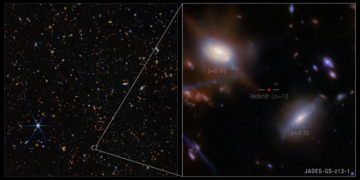Imagine peering back in time to witness the universe in its infancy, a mere 330 million years after the Big Bang. Thanks to the James Webb Space Telescope (JWST), astronomers have achieved just that, unveiling a galaxy so ancient and luminous that it’s reshaping our understanding of the cosmos. This discovery, featuring the galaxy JADES-GS-z13-1, challenges existing models of cosmic evolution and reionization, offering valuable insights into the universe’s earliest moments.
A Glimpse into the Cosmic Dawn
JADES-GS-z13-1 is not just another distant galaxy; it is a time capsule from the early universe. Scientists identified this galaxy through JWST’s NIRCam imaging as part of the JWST Advanced Deep Extragalactic Survey (JADES). Its redshift measurement of approximately 13.0 confirms its existence only 330 million years after the Big Bang, making it one of the most distant galaxies ever observed.
Their formation, composition, and light emissions reveal information about the conditions of the early cosmos, including the transition from the dark ages—a period when the universe was filled with neutral hydrogen that absorbed most light—to the epoch of reionization, when the first stars and galaxies ionized the surrounding gas, allowing light to travel freely.
The Mystery of Lyman-Alpha Emission
One of the most perplexing aspects of JADES-GS-z13-1 is its unexpectedly strong Lyman-alpha emission. Lyman-alpha radiation is a specific type of ultraviolet light emitted by hydrogen atoms. In the early universe, such radiation was believed to be mostly absorbed by dense neutral hydrogen, making it difficult to detect from galaxies of this era.
However, JADES-GS-z13-1 appears to be emitting Lyman-alpha radiation far more intensely than expected, leading scientists to question previous assumptions about how and when the universe became transparent. This suggests two possibilities:
- The cosmic fog lifted earlier than expected: The presence of Lyman-alpha emissions might indicate that reionization began sooner or occurred in isolated pockets earlier than believed.
- The galaxy created an ionized bubble around itself: Powerful radiation from JADES-GS-z13-1 could have cleared out a region of ionized hydrogen, allowing its emissions to escape into space.
What Could Be Causing This Unexpected Brightness?
What is producing such intense emissions from this galaxy? Scientists propose two leading explanations:
1. Population III Stars – The First Generation of Stars
One theory suggests that the brightness of JADES-GS-z13-1 comes from Population III stars—hypothetical first-generation stars composed entirely of primordial hydrogen and helium. These stars are believed to be:
- Extremely massive, potentially hundreds of times the mass of our Sun.
- Exceptionally hot and bright, emitting enormous amounts of ultraviolet radiation.
- Short-lived, rapidly burning through their fuel and influencing early galaxy formation.
If JADES-GS-z13-1 is home to Population III stars, it would be direct evidence of the universe’s earliest star formation. Their presence would explain why the galaxy emits so much energy and could provide crucial insights into the formation of heavy elements necessary for planet and life formation.
2. A Growing Supermassive Black Hole
Another possibility is that JADES-GS-z13-1 hosts an active galactic nucleus (AGN) powered by a supermassive black hole. If this were the case, then:
- The black hole would be rapidly accreting material, heating up gas around it and producing powerful radiation.
- It could generate energetic outflows, clearing space in the surrounding hydrogen fog and allowing Lyman-alpha emissions to escape.
- It would suggest that supermassive black holes formed much earlier than previously thought, reshaping our understanding of their role in the early universe.
Both scenarios are equally fascinating and will require additional studies to determine which one—if not both—is responsible for this unexpected brightness.
Why This Discovery Matters
- Revising the timeline of reionization: If light escaped this early, reionization may have been a more complex and faster process than our models predict.
- Understanding the first galaxies: Learning how early galaxies formed and evolved helps us understand the origins of today’s galaxies, including the Milky Way.
- Unraveling the birth of black holes: If the emissions come from an early AGN, it would suggest that supermassive black holes formed far earlier than anticipated.
- Searching for Population III stars: Finding these first-generation stars would be a groundbreaking achievement, confirming long-standing theories about stellar evolution.
The Role of JWST in Cosmic Exploration
The James Webb Space Telescope has once again demonstrated its unparalleled capabilities in uncovering hidden secrets of the early universe. Unlike previous telescopes, JWST’s infrared capabilities allow it to see through dust and capture the faint, redshifted light of some of the universe’s earliest galaxies.
Its success in detecting JADES-GS-z13-1 means that more discoveries of similar galaxies may be on the horizon. Future observations will help scientists:
- Identify more high-redshift galaxies.
- Analyze the chemical compositions of these ancient galaxies.
- Refine theories about early star formation and cosmic reionization.
JWST is not only confirming existing theories but challenging and refining them, proving itself as one of the most powerful tools ever built for cosmic exploration.
What Comes Next?
This discovery is just the beginning. Scientists plan to conduct further spectroscopic studies to analyze JADES-GS-z13-1’s properties in more detail. Additionally, upcoming missions and next-generation telescopes like the Nancy Grace Roman Space Telescope and the Extremely Large Telescope (ELT) will provide even deeper insights into the universe’s infancy.
With every new discovery, we come closer to answering fundamental questions about our cosmic origins, from the formation of the first galaxies to the evolution of the universe as we know it today.
Conclusion
The unveiling of JADES-GS-z13-1 represents a giant leap forward in our understanding of the early universe. It challenges long-held theories, raises new questions, and sets the stage for exciting future discoveries. Whether it hosts the elusive Population III stars or an early supermassive black hole, this galaxy is a beacon from the past, illuminating the mysteries of the cosmos.



















